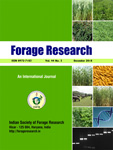H. K. OBEROI* AND G. KAUR
Department of Plant Breeding and Genetics, Punjab Agricultural University, Ludhiana-141 004 (Punjab), India
Department of Biochemistry, Punjab Agricultural University, Ludhiana-141 004 (Punjab), India
*(e-mail: harpreetoberoi@pau.edu)
(Received : 08 February 2025; Accepted : 27 March 2025)
SUMMARY
Plant growth and productivity are significantly impacted by a variety of biotic and abiotic
stress factors. Among these, water deficit stress-whether temporary or permanent-has a greater
impact on the growth and performance of cultivated plants than most other environmental factors.
Water stress is a major issue in agriculture, and the ability of crops to endure such stress is of
immense economic value. Drought, as a complex physical-chemical process, adversely affects nearly
every aspect of plant metabolism. As a result, it is crucial to understand how crops adapt at
morphological, physiological, biochemical, and molecular levels under water deficit conditions. This
review aims to provide an overview of research on the mechanisms of drought tolerance in plants.
Key words: Drought stress, antioxidants, enzymes, molecular changes

